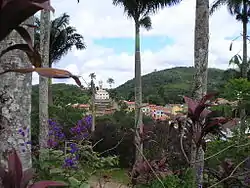Guaramiranga
Guaramiranga is one of the smallest towns of the Northeastern state of Ceará in Brazil. It is located at an altitude of 865 m in the Serra de Baturité hills 110 km from the state capital of Fortaleza. Guaramiranga is known locally for its temperate climate and lush green scenery. The temperature in Guaramiranga varies between 15 and 23 degrees Celsius through the year.
Guaramiranga | |
|---|---|
 A view of the main church of the city | |
| Nickname(s): "Cidade Jardim" (Garden City) or "Cidade das Flores" (City of Flowers) | |
 Location of Guaramiranga in the State of Ceará | |
| Coordinates: 04°15′46″S 38°55′58″W | |
| Country | |
| Region | Northeast |
| State | |
| Founded | September 1, 1890 |
| Government | |
| • Mayor | Luis Eduardo Vieira Viana (PR) |
| Area | |
| • Total | 90.817 km2 (35.065 sq mi) |
| Elevation | 865 m (2,838 ft) |
| Population (2020 [1]) | |
| • Total | 5,132 |
| • Density | 57/km2 (150/sq mi) |
| Demonym(s) | guaramiranguense |
| Time zone | UTC-3 (UTC-3) |
| HDI (2000) | 0.654 – medium[2] |
| Website | www.santaquiteria.ce.gov.br/ |


Guaramiranga has a population of about 5,132 people. The town was first populated by an Indian tribe called the Tarariús towards the end of the 19th century.
Guaramiranga hosts a number of events throughout the year including a Festival of Jazz&Blues which is held every year during Carnival, and the Ceará Fest Flores which is held in November.
Guaramiranga has two large churches, the Igreja Matriz Nossa Senhora da Conceição and the Igreja Nossa Senhora de Lourdes.
The town is the birthplace of the scientist and researcher Fernando de Mendonça, founder of Brazil's National Institute for Space Research.
Within its territory, lies the Pico Alto, the highest point of Ceará.